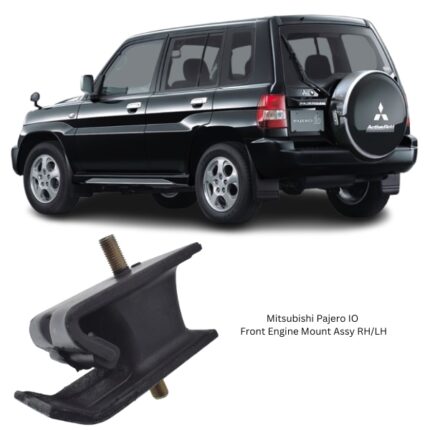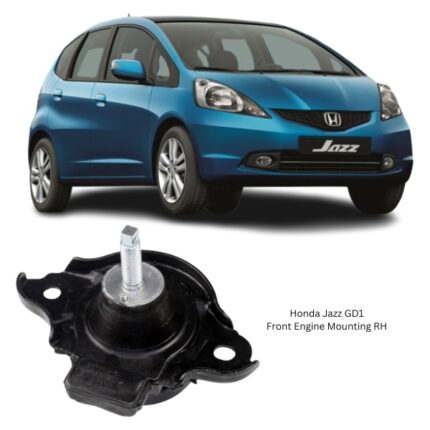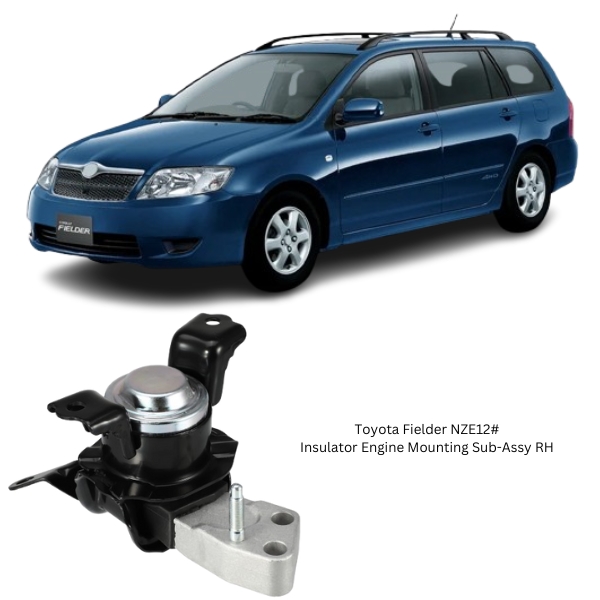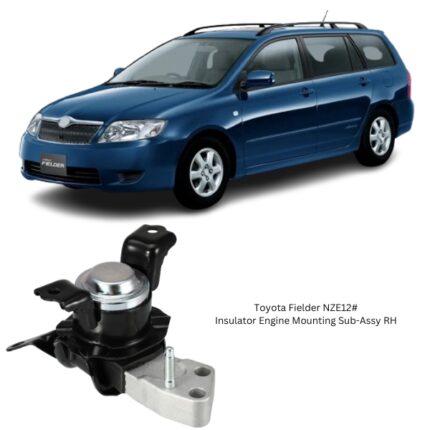Get Toyota Fielder NZE12# Insulator Engine Mounting Sub-Assy RH 12305-21130 in Kenya
The Insulator Engine Mounting Sub-Assembly RH (Right-Hand Side) is a critical component in a vehicle’s engine support system. It performs the dual function of mechanically securing the engine and dampening the vibrations and dynamic forces generated during engine operation. Specifically positioned on the right-hand side of the engine bay, this component is essential in maintaining the engine’s stability, ensuring cabin comfort, and preserving the health of adjacent drivetrain systems.
Modern internal combustion engines generate significant vibrations and torque reactions as they operate. Without proper isolation, these forces can be transferred into the vehicle chassis and ultimately into the cabin, resulting in uncomfortable driving conditions and potential mechanical failures. The RH engine mount insulator sub-assembly absorbs these forces and ensures that the engine remains properly aligned under various operating conditions.
Core Functions and Responsibilities
The RH insulator engine mounting sub-assembly fulfills several important roles, including:
-
Support and Stabilization
It supports part of the engine’s weight, preventing excessive sagging or tilting and anchoring the engine to the frame or subframe. -
Vibration Damping
It absorbs engine-generated vibrations and prevents them from being transmitted into the passenger cabin, especially at idle or low RPMs. -
Torque Management
It resists and controls the engine’s tendency to rock or twist under acceleration, deceleration, and gear changes. -
Component Protection
It reduces motion-related stress on surrounding components such as the exhaust manifold, drive axles, hoses, belts, and wiring harnesses. -
Driveline Alignment
It helps maintain precise alignment between the engine, transmission, and driveline components, improving performance and longevity.
Collectively, these functions ensure smoother operation, improved ride comfort, and enhanced system reliability.
Design and Material Composition
The RH engine mount insulator sub-assembly is engineered with a combination of high-strength materials and precision molding techniques to endure prolonged mechanical and environmental stress.
Key Structural Elements:
-
Metal Bracket or Housing
This is usually made from cast aluminum or high-strength stamped steel and forms the structural backbone of the mount. It features machined mounting surfaces and bolt holes for precise installation. -
Elastomeric Core (Rubber or Polyurethane)
The insulating element is made of vulcanized natural rubber or high-performance polyurethane, molded between the metal housings. This material flexes under engine load and vibration. -
Central Bushing or Sleeve
This metal tube allows a mounting bolt to pass through the center, anchoring the engine while permitting limited movement. -
Hydraulic Chamber (in some variants)
In advanced models, a fluid-filled chamber is embedded within the rubber insulator to provide superior vibration damping, especially at low frequencies. -
Anti-Corrosion Treatment
Coatings such as zinc plating or powder coating are applied to resist corrosion from engine fluids, road salt, and moisture. -
Heat Shield (where applicable)
Some variants include an integrated or attached heat shield to protect the elastomer from radiant heat produced by nearby exhaust components.
Together, these materials and design elements offer strength, flexibility, and resilience to environmental wear.
Performance Characteristics
The RH engine mount insulator sub-assy is subject to dynamic forces from the engine, road conditions, and vehicle movement. To perform effectively, it must provide:
-
High Load-Bearing Capacity
Capable of supporting the engine’s static weight and resisting forces from engine torque and road shocks. -
Durable Vibration Isolation
Designed to reduce NVH (Noise, Vibration, Harshness) for a smoother and quieter driving experience. -
Fatigue Resistance
Withstands thousands of compression and tension cycles without deforming or cracking. -
Thermal Tolerance
Maintains performance in engine compartments with temperatures exceeding 100°C. -
Chemical Resistance
Impervious to damage from engine oil, coolant, fuel, and other under-hood chemicals.
This performance ensures optimal functionality under all types of driving conditions—from stop-and-go traffic to highway cruising and rough terrain.
Signs of Wear or Failure
Over time, the right-hand engine mount insulator may degrade due to exposure to heat, fluids, and mechanical stress. Common indicators of a worn or failing RH mount include:
-
Excessive Engine Vibration
Vibrations felt through the floorboard, steering wheel, or seats, especially at idle, often indicate that the rubber element has hardened, cracked, or collapsed. -
Knocking or Clunking Sounds
Sudden noises during gear shifts, acceleration, or deceleration can signal excessive engine movement due to a compromised mount. -
Visible Deterioration
Signs such as cracked rubber, separated layers, or oil-soaked elastomer are common in mounts exposed to leaks. -
Engine Rock or Tilt
Observing the engine move back and forth while revving in neutral or during take-off is a symptom of a failing mount. -
Fluid Leaks (in hydraulic mounts)
A ruptured hydraulic chamber may leak fluid and lead to a sudden increase in vibration. -
Misalignment of Connected Systems
Misalignment of belts, cooling hoses, or drive axles may result from a sagging mount.
Prompt replacement helps prevent secondary damage and ensures smooth engine operation.
Installation Guidelines
Proper installation of the RH engine mount insulator sub-assembly is crucial to restore correct engine positioning and minimize vibrations.
General Installation Steps:
-
Safety Precautions
Park the vehicle on a flat surface. Disconnect the battery and allow the engine to cool. -
Support the Engine
Use a floor jack with a wooden block or an overhead support bar to hold the engine in place. -
Remove Old Mount
Unbolt the existing RH mount from both the engine block and the chassis. Take care to note the orientation and bolt patterns. -
Install New Mount
Position the new mount correctly. Insert bolts and torque them according to manufacturer specifications. -
Re-check Alignment
Confirm that the engine is level and aligned with adjacent mounts and components. -
Test Engine Operation
Start the engine and observe for abnormal movement, noise, or vibration.
Professional installation is recommended to ensure engine alignment and torque specifications are correctly applied.
Inspection and Maintenance Tips
Although not serviceable, the mount should be inspected periodically during oil changes or routine service checks.
What to inspect:
-
Cracks or deformation in the rubber
-
Oil contamination or fluid leaks
-
Mounting bolt tightness
-
Engine position and vibration levels
Early detection of issues can prevent costly mechanical repairs and maintain vehicle reliability.
Benefits of Replacing a Worn RH Mount
-
Restores Engine Stability
Prevents excessive engine rocking and maintains correct alignment. -
Reduces Cabin Noise and Vibration
Improves driver and passenger comfort by isolating engine vibrations. -
Protects Adjacent Systems
Prevents stress on driveshafts, exhaust systems, wiring, and cooling components. -
Maintains Performance
Ensures smoother gear transitions and throttle response. -
Extends Engine Mount System Life
Replacing one mount can prevent uneven wear and premature failure of others.
Follow us on Facebook for more parts.





Reviews
Clear filtersThere are no reviews yet.